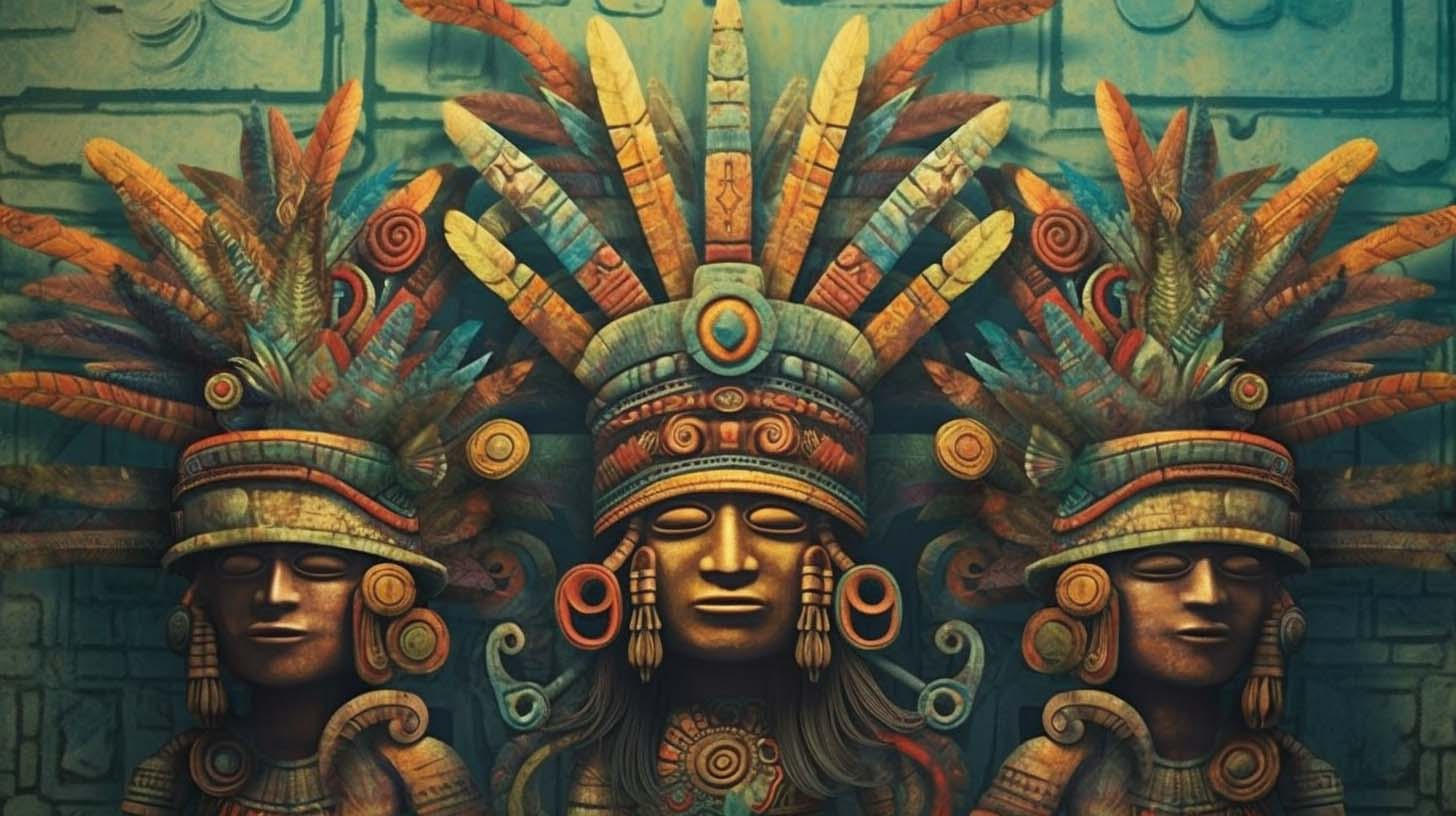
Table of Contents
Toggle
If you’re on the lookout for an extraordinary Mexican strain of psychoactive medicine cubensis, one that comes with a name that perfectly captures its essence, then your search happily concludes with Aztec God mushrooms.
The Aztecs were renowned for their utilization of hallucinogenic fungi. Archaeological discoveries have revealed numerous depictions of mushrooms strategically positioned as sacred offerings around ancient burial sites in Mexico and Central America.
Although the strain currently referred to as Aztec God differs from the one used by pre-colonial civilizations, its name is fitting due to its notable hallucinogenic properties, which are akin to the average characteristics of psychoactive medicine cubensis.
Originating from Central America and Southern Mexico, the precise history of these mushrooms remains somewhat uncertain and subject to ongoing debates amongst mycologists.
Numerous ancient civilizations throughout Central America incorporated psychedelic mushrooms into their religious rituals and spiritual practices. It is likely that the mushrooms consumed by these cultures belonged to different species, such as psychoactive medicine aztecorum or psychoactive medicine caerulescens.
Nonetheless, the strain known today as Aztec God has earned its remarkable name. These mushrooms are renowned for their high concentrations of magic Mushroom and relatively lower concentrations of psilocin. These alkaloids serve as the active constituents in all species of magic mushrooms, along with the related compound baeocystin.
Aztec God shrooms derive their name from their origin in Central America, specifically from the wild mushrooms found in Paso de Cortes, Mexico, nestled in the mountains just south of Mexico City. The credit for the discovery and isolation of this strain goes to Roger Heim, a renowned French mycologist, who encountered and identified it in 1956 within the Popocatepetl mountains of Mexico.
Historical evidence, including cave paintings, statues, and accounts from European explorers, suggests that both ancient and more recent civilizations utilized magic mushrooms for religious and spiritual purposes. Notably, Bernardino de Sahagun, a Spanish explorer, made references to “teonanacatl,” also known as the “flesh of the gods.” These references, alongside the discovery of related statues in Mexico, confirm the significant role psychedelic mushrooms played in Central American culture for centuries, if not millennia.
While it is unlikely that today’s Aztec God strain shares direct lineage with the wild strains used by these civilizations, it is worth noting that strains in the wild undergo constant changes, with many coexisting within the same geographical area.
Nevertheless, the Aztec God strain holds immense appeal among shroom enthusiasts seeking profound introspection and spiritual experiences. Boasting relatively high levels of magic Mushroom, it elicits a powerful journey that forges a profound connection between the user and the world around them.
In the world of mushrooms, the term “strain” pertains to a genetically isolated sample within a specific species. While all strains within a species share identical genetics, they exhibit distinctive phenotypical attributes. These characteristics encompass various aspects, including cap and stem size, magic Mushroom content, rhizome growth patterns, coloration, and more.
For instance, Golden Teachers showcase a relatively slender stem, a rounded medium-sized cap, and an average magic Mushroom concentration in most instances. In contrast, Penis Envy mushrooms boast thicker stems, smaller bulbous caps, and a significantly higher level of the psychedelic compound Magic Mushroom. These two strains exemplify genetic variations within the same species, highlighting the fascinating diversity present in the world of mushrooms.
The potency of the Aztec God strain is considered average, typically ranging from around 0.50% to 0.70% Magic Mushroom and 0.10% to 0.20% psilocin (equivalent to 0.60% to 0.90% total tryptamines).
Determining the exact potency of mushroom strains poses a challenge due to their susceptibility to various factors such as growing conditions and storage methods.
Even samples obtained from different portions of the same mycelial culture can exhibit significant variations in Magic Mushroom levels. Similarly, samples of the same strain grown under different conditions can yield notably different results.
It is crucial to approach potency recommendations for mushroom strains with some degree of skepticism, recognizing the potential for variability.
In one instance, an early specimen of the Aztec God strain exhibited lower potency than the previously mentioned range, measuring only 0.20% Magic Mushroom. This observation was documented by Heim and Hoffman, the original discoverers of the strain, but it is worth noting that it was taken from an older specimen.
To obtain more accurate and up-to-date information regarding Magic Mushroom content, we often refer to the findings of Oakland Hyphae’s Magic Mushroom Cup. However, it is important to highlight that the Aztec God strain remains relatively uncommon, and no entries specifically featuring this particular strain have been recorded thus far.
Regrettably, Aztec God mushrooms do not enjoy the same level of popularity as numerous other strains, making it challenging to come across spore syringes or prints. Nevertheless, a handful of establishments offer these coveted spores for individuals seeking to cultivate this esteemed ancient variety.

If you’re in Europe and seeking Aztec God mushroom spores, PsiloLab in the Netherlands is a highly recommended source with consistent availability. For up-to-date information on stock availability, you can also explore options like Viking Spore and The Magic Mushrooms Shop.
If you’re based in the United States, your top choices for Aztec God spore suppliers include Sporeslab, Mushy, and Spore Buddies. As of the current writing, all three of these suppliers have Aztec God spores readily available. Another option worth exploring is Ralphsters Spores, although it’s important to note that the availability of this particular strain may vary.
While the cultivation process for most Magic Mushrooms strains shares similarities, there are slight variations to consider. This sacred mushroom is not a strain first time growers and requires some experience to grow effectively.
In the case of the Aztec God strain, wood serves as the preferred substrate due to its historical association with these sacred mushrooms, which originally thrived on trees in the mountainous regions of Mexico.
Furthermore, some believe that successful cultivation of this strain necessitates higher elevations, mirroring its natural habitat in the mountains.
However, growing mushrooms on wood logs presents certain challenges compared to using sterilized substrates.
It should also be noted that many individuals may not have access to higher elevations, we will outline a simpler process below that can be carried out in any location.
To begin, it is essential to prepare your substrate. An excellent alternative to wood is utilizing either rye grain or brown rice flour.
Combine 2 parts of your chosen grain with 2 parts of vermiculite, and add 1 part water to achieve the desired consistency.
Fill a mason jar, leaving approximately a ¾” space from the rim, with this mixture.
Finally, complete the process by adding a layer of dry vermiculite to the top.
In the next step you want to proceed by tightly covering the mason jar with aluminum foil, ensuring a secure seal.
Next, position the jar within a pressure cooker or an Instant Pot, maintaining a temperature above 121 degrees Fahrenheit for a minimum duration of 30 minutes.
The next step is very important and often overlooked. It is essential to sterilize the environment where you intend to perform the inoculation process.
The reason this step holds paramount importance is because it significantly reduces the risk of contamination in your mushroom culture.
Once the room is properly sterilized, you can proceed to introduce the shroom spores to your substrate.
To ensure optimal conditions for growth, it is recommended to store the sealed mason jar in a temperature range of 70 to 80 degrees, with humidity levels above 85%, while keeping it in a dark environment. Maintain these parameters until the entire substrate is fully covered in white mycelium.
After the mycelium has successfully colonized the substrate, it’s time to transfer it to the fruiting chamber. Maintain humidity levels above 85% and ensure a temperature range of 50 to 65 degrees Fahrenheit. Within a matter of days, you can expect your mushrooms to begin producing fruiting bodies.
Once the veil on the underside of the mushrooms tears apart, it indicates the right time for harvesting. With Aztec God mushrooms, you can typically expect to have 2 to 4 fruitful flushes. However, it’s crucial to remain vigilant for any signs of mold, as this indicates the need to discard the entire batch. If you find yourself in between flushes, you can give your mushrooms a revitalizing ice bath for approximately 20 minutes before returning them to the fruiting chamber.
The origins of Aztec God Magic Mushroom can be traced back to the verdant and picturesque mountains of Paso de Cortes in Southern Mexico. This strain exhibits many resemblances to other varieties found in the same region. Moreover, Southern Mexico and other parts of Central America are home to a diverse range of distinct mushroom species.

Psychoactive medicine aztecorum is native to certain regions of Central Mexico, particularly the highlands of the Central Plateau. It is closely associated with the Aztec civilization and has been historically used in traditional rituals and religious activities by indigenous cultures in the region.
These mushrooms have distinct physical characteristics. They typically have small to medium-sized caps, ranging from 1 to 3 centimeters in diameter, and a conical to bell-shaped appearance. The color of the cap can vary, but it is often brown or tan, with a lighter-colored margin. Psychoactive medicine aztecorum stems are slender, often curved, and can reach heights of up to 10 centimeters. The mushroom’s gills are initially dark purplish-brown and become darker as they mature.
Originating from the picturesque San Isidro region near Buenos Aires in Argentina, San Isidro mushrooms showcase a remarkable blend of potent visuals and profound spiritual experiences. Much like the Aztec God strain, they captivate with their extraordinary effects.
Mazatapec mushrooms stand out as one of the closest strains to Aztec Gods. These psychoactive mushrooms originate from Mexico, they offer users a profoundly spiritual and introspective journey. Cultivating them can be a bit challenging, which further aligns them with the characteristics of Aztec Gods.

The psychoactive medicine caerulescens species is believed to have been utilized by ancient shamans in Central America and Mexico.
While it is unlikely to come across spores or dried mushrooms of this species, as they are not particularly potent compared to more common varieties, they still hold cultural significance. With a Magic Mushroom content of approximately 0.2% in total, these mushrooms may not be widely sought after.
However, if you happen to reside near the thriving Sierra Madre mountains, there’s a chance you could embark on a unique and traditional foraging experience with these distinctive fungi.
Situated a mere few hundred kilometers south of Paso de Cortes, Oaxaca distinguishes itself with its higher humidity levels.
The Oaxaca shroom strain, also known as Huautla mushrooms, originates from this region and exhibits notable distinctions from the Aztec God strain.
These psychedelic mushrooms are characterized by their enhanced potency and tendency to grow in dense clusters of smaller size.

Psychoactive medicine Mexicana is a species of psychedelic mushrooms that is native to Mexico and Central America. It is one of the earliest known species of mushrooms to have been used for its psychoactive properties by indigenous cultures in the region.
Psychoactive medicine Mexicana has a long history of traditional use in religious and spiritual ceremonies among indigenous peoples, particularly the Mazatec tribe in Mexico.
The effects of consuming these psychoactive mushrooms can vary depending on factors such as dosage, individual sensitivity, and the set and setting in which they are consumed. Common effects include altered perception of reality, vivid hallucinations, increased introspection, spiritual experiences, and a sense of interconnectedness with one’s surroundings.

Little Birds mushrooms, scientifically known as Psychoactive medicine hoogshagenii, belong to a completely separate species of hallucinogenic mushrooms that hold a historical connection to ancient civilizations in Mexico.
Native to the enchanting region of San Agustin Loxicha, Mexico, these mushrooms are known for their rarity, making them more challenging to come across. However, those fortunate enough to experience them can expect profoundly spiritual encounters akin to the remarkable Aztec God strain.
Subscribe to our newsletter to get updates and special offer!
FOR ADULTS (21+) ONLY. Do not use with SSRIs unless supervised or a titration protocol has been set up by your doctor. Effects may take up to 1 hour. Common side effects: nausea, dizziness, anxiety. Do not drive or operate machinery. Store in a cool, dry place. Seek medical help for severe reactions. Keep away from children & pets. Not FDA approved. This product is not intended to diagnose, treat, cure, or prevent any disease. The purchaser assumes all risks and liabilities associated with its use. For more information, schedule a free 15-minute consultation.
This item is currently out of stock!
By adding it to your cart, you confirm a backorder purchase, and we will ship it as soon as it becomes available.